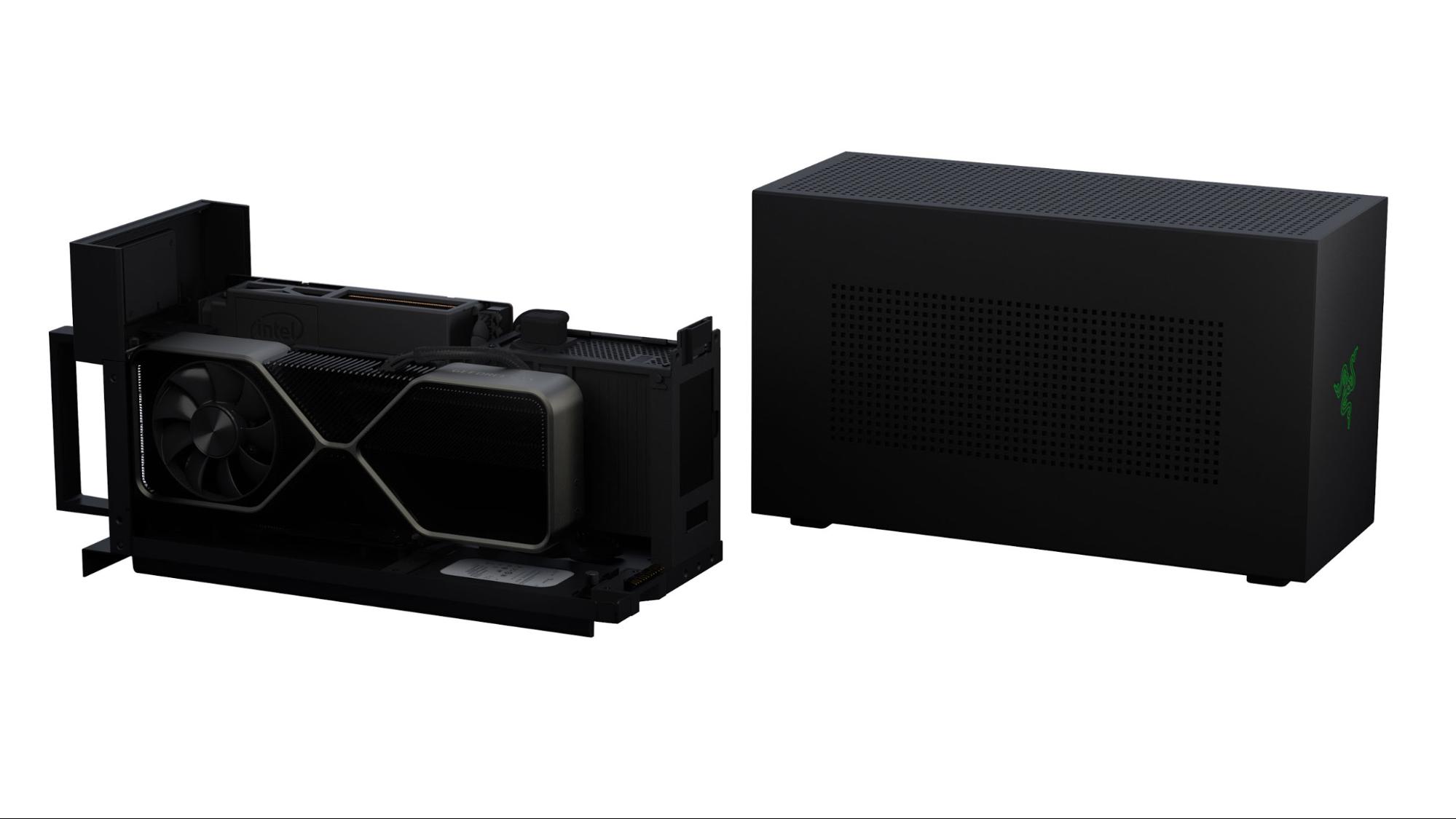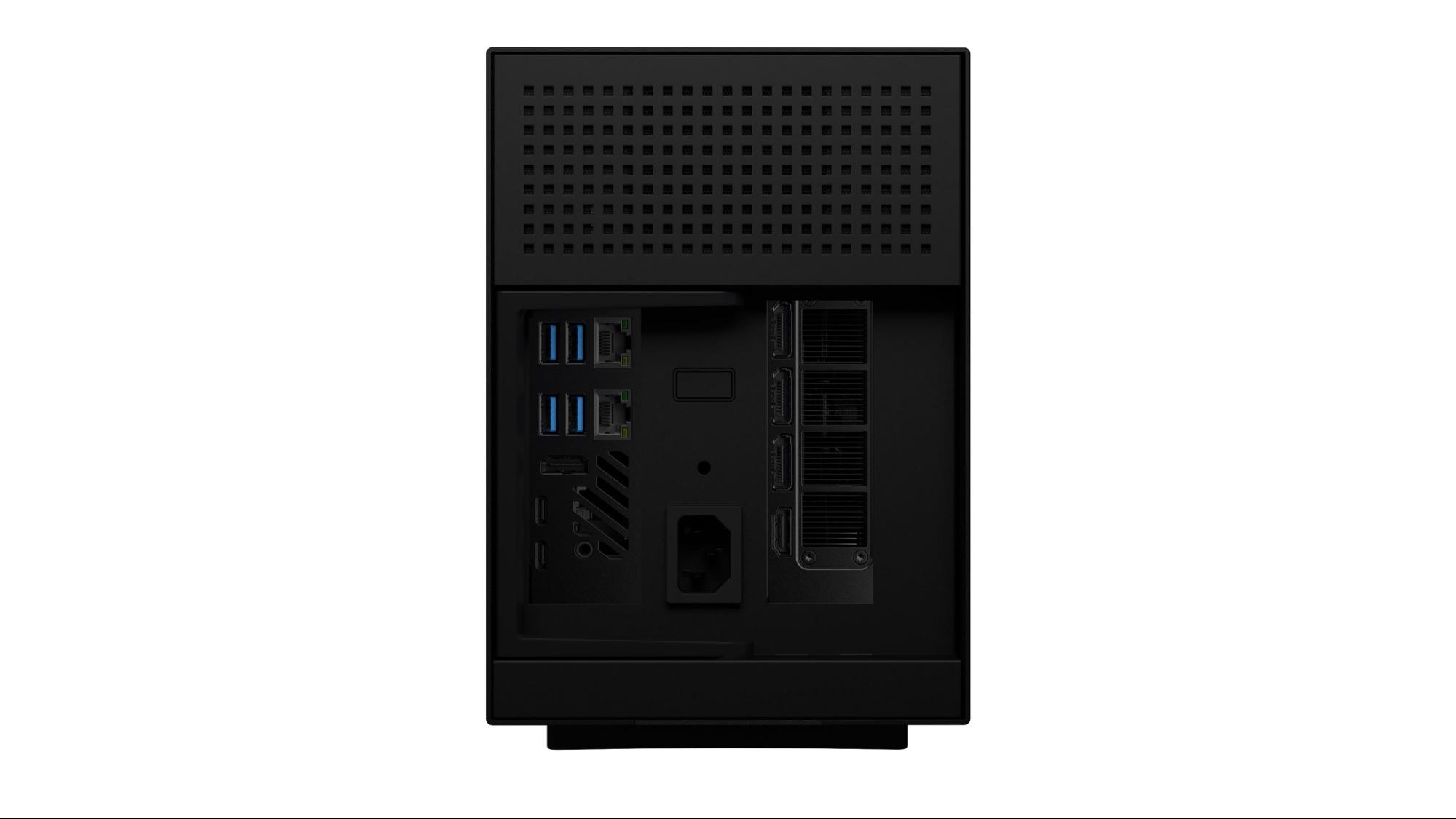Razer Is Finally Releasing Tomahawk Gaming Desktop, Now With RTX 3080
The second desktop with Intel's Compute Element
Eleven months to the day we saw it at CES 2020, Razer is launching the Razer Tomahawk Gaming Desktop, a tiny PC in a 10-liter chassis powered by an Intel Compute Element with an Intel Core i9-9980HK. It's available for pre-order this month, exclusively on Razer's website.
There are two versions of the Tomahawk Gaming Desktop - one that pairs the Compute Unit with an Nvidia GeForce RTX 3080 Founders Edition, while the other has an unpopulated PCIe x16 slot for you to bring your own GPU. But you'll pay a significant price for this form factor: The Tomahawk is $2,399.99 without a GPU or $3,199.99 with an RTX 3080, making it more expensive than many of the best gaming PCs.
That CPU is a bit long in the tooth, as it has been supplanted by 10th Gen Comet Lake H-series chips, though those never showed up in a Compute Unit. The Tiger Lake H-series processors haven't been released yet, and it's unclear if or when those will be in one of Intel's modules.
The two configurations are identical otherwise, with a 512GB PCIe NVMe SSD paired with a 2TB HDD at 5,400 RPM. There's an additional M.2 slot if you want to add more storage. Additionally, the Tomahawk comes with 16GB of DDR4 RAM installed in the Compute Unit, and a 750W PSU is preinstalled in the case.
| CPU | Intel Core i9-9980HK |
| GPU | None, or Nvidia GeForce RTX 3080 |
| RAM | 16GB DDR4-2667MHz |
| Storage | 512GB PCIe NVMe SSD, 2TB HDD (5,400 RPM). extra PCIe NVMe slot |
| Connectivity | Wi-Fi 6 (Intel AX200), Bluetooth 5.0 |
| Size | 24.2 x 19.2 x 1.5 inches (365 x 210 x 150 mm) |
| Price | $2,399.99 without GPU, $3,199.99 with RTX 3080 |
The ports are largely what is on the Compute Unit, including two Thunderbolt 3 ports, a pair of Ethernet ports, four USB 3.2 Gen 2 Type-A ports, HDMI 2.0A and a headphone jack. What's on the GPU will depend if you get the RTX 3080 Founders Edition or bring your own. Notably, there don't appear to be any front panel ports.
Beyond the cooler on the Compute Unit and the GPU, there are two top-mounted 120 mm fans, pulling air in the side and expelling it through the top. While we saw the case with a glass side panel back at CES, it looks like they're going for aluminum with air holes instead.



Razer's case is tool-free. You can pull on a door to remove most of the parts on a sled from inside the case, should you want to make any upgrades.
Get Tom's Hardware's best news and in-depth reviews, straight to your inbox.
It's been a fairly quiet year for Intel's Compute Element push. We reviewed the Intel NUC 9 Extreme Kit in the spring, but that's the only desktop we'd seen with Intel's new form factor actually release, despite multiple announcements at CES. That is, until now.
While Razer's case, at 10 liters, is larger than what Intel brought to the table itself, it allows for a wider variety of graphics cards, better cooling and more storage options. If you're someone with a small apartment or dorm room, it should still allow fairly powerful gaming in your space. (My ATX mid-tower has started to feel big since I've spent months in the same small apartment.) But it's unclear when the next Compute Element upgrade will come, and you can't replace the CPU otherwise.
If Intel puts out more of these Compute Units at a more regular cadence with more CPUs, machines like this one could be promising for those who are small on space or need to take computers otherwise. But as a challenger to ITX PCs, there's not as much upgradeability available right now.

Andrew E. Freedman is a senior editor at Tom's Hardware focusing on laptops, desktops and gaming. He also keeps up with the latest news. A lover of all things gaming and tech, his previous work has shown up in Tom's Guide, Laptop Mag, Kotaku, PCMag and Complex, among others. Follow him on Threads @FreedmanAE and BlueSky @andrewfreedman.net. You can send him tips on Signal: andrewfreedman.01
-
Zescion Agree, insanely priced, but I wish to see more of these small form factor builds.Reply
To my knowledge, there's no so small cases to build your own Htpc (10 liters).
Please link if you know any -
deesider Reply
https://premiumbuilds.com/small-form-factor/best-dancase-a4-sfx-louqe-ghost-s1-alternative-cases/Zescion said:Agree, insanely priced, but I wish to see more of these small form factor builds.
To my knowledge, there's no so small cases to build your own Htpc (10 liters).
Please link if you know any -
Zescion Reply
Thanks a lot.deesider said:https://premiumbuilds.com/small-form-factor/best-dancase-a4-sfx-louqe-ghost-s1-alternative-cases/
Several of them are really nice, the thor in particular, given they end up commercializing it -
Nemesia Hmmm???Reply
2400 Without the GPU? That is insane.
No Motherboard model here (The Tomahawk?) No RAM brand specified. No PSU specification. It's scary for that price really.
CPUIntel Core i9-9980HKGPUNone, or Nvidia GeForce RTX 3080RAM16GB DDR4-2667MHzStorage512GB PCIe NVMe SSD, 2TB HDD (5,400 RPM). extra PCIe NVMe slotConnectivityWi-Fi 6 (Intel AX200), Bluetooth 5.0Size24.2 x 19.2 x 1.5 inches (365 x 210 x 150 mm)Price$2,399.99 without GPU, $3,199.99 with RTX 3080 -
Nemesia Let's compare. That is crazy. 2334 or 3200. Even added 32GB of RAM and nowhere near close to the 3200. Can you say a nice profit?Reply
PCPartPicker Part List
CPU: Intel Core i9-10900K 3.7 GHz 10-Core Processor ($539.99 @ Adorama)
CPU Cooler: Noctua NH-D15 82.5 CFM CPU Cooler ($89.99 @ Newegg)
Motherboard: Asus ROG STRIX Z490-E GAMING ATX LGA1200 Motherboard ($285.99 @ Amazon)
Memory: G.Skill Ripjaws V 32 GB (2 x 16 GB) DDR4-3600 CL16 Memory ($148.99 @ Newegg)
Storage: Crucial P5 1 TB M.2-2280 NVME Solid State Drive ($119.99 @ Amazon)
Storage: Seagate Barracuda Compute 2 TB 3.5" 7200RPM Internal Hard Drive ($51.99 @ Adorama)
Video Card: MSI GeForce RTX 3080 10 GB GAMING X TRIO Video Card ($780.00)
Case: Corsair 4000D Airflow ATX Mid Tower Case ($79.99 @ Best Buy)
Power Supply: Corsair RMx (2018) 850 W 80+ Gold Certified Fully Modular ATX Power Supply ($129.00)
Operating System: Microsoft Windows 10 Home OEM 64-bit ($108.78 @ Other World Computing)
Total: $2334.71
Prices include shipping, taxes, and discounts when available
Generated by PCPartPicker 2020-12-04 17:24 EST-0500